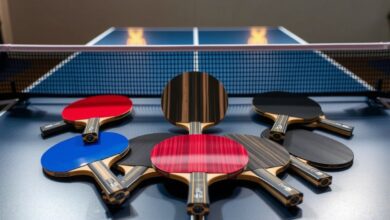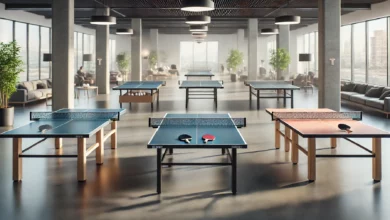The Ultimate Ping Pong Paddle Guide
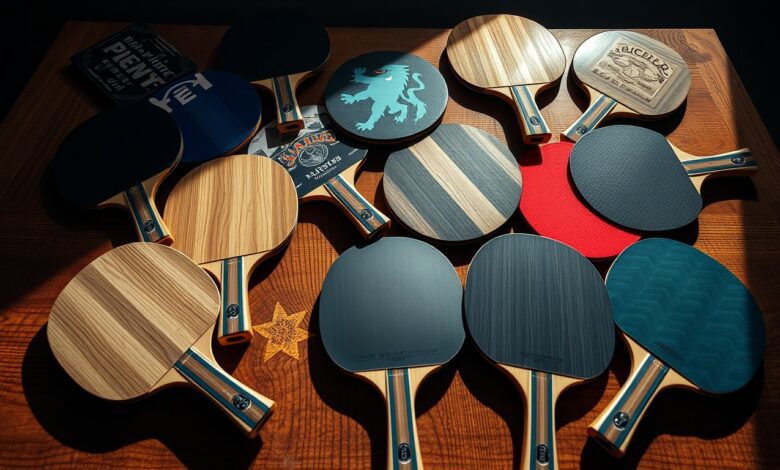
As a table tennis enthusiast, you know that having the right equipment can make all the difference in your game. And at the heart of every successful player’s arsenal is a high-quality ping pong paddle. But with countless options available, finding the perfect racket can be a daunting task. In this comprehensive guide, we will explore the important factors to consider when shopping for a ping pong paddle, helping you unlock your true table tennis potential.
Key Takeaways:
- Grip Matters: A comfortable and secure grip is necessary for optimal performance, with handle shape influencing playing style.
- Blade Composition: The number of layers and materials used in the blade affect its speed, control, and flexibility, with 7-ply, 6-ply, and 5-ply blades offering different characteristics.
- Rubber Type and Thickness: Smooth rubber provides control and spin, while pimpled rubber offers increased spin and speed, with 2mm thick rubber being standard regulation.
- Spin, Control, Speed, and Power: Paddles can be designed for spin, control, speed, or power, depending on the player’s style and preferences.
- Weight and Balance: Finding the right weight and balance is crucial for comfort and maneuverability during matches.
Also read: Top 10 Best Ping Pong Tables For Home Use
Also read: Top 10 Best Ping Pong Paddles – Table Tennis Racket Guide
Factors to Consider When Choosing a Ping Pong Paddle
While selecting the perfect ping pong paddle can seem overwhelming, understanding the key factors to consider can make all the difference in your game. Here are the crucial elements to think about when choosing a ping pong paddle:
- Grip: The grip should be comfortable and provide a secure hold. The handle shape should match your playing style and grip strength.
- Blade: The composition and number of layers of the blade determine its performance and characteristics. Some blades incorporate additional materials like carbon fiber for added speed and control.
- Rubber: Different rubber types and thicknesses affect the interaction with the ball. Smooth rubbers offer good control and spin, while pimpled rubbers provide increased spin and speed.
- Spin and Control: Specific paddle features, such as rubber patterns and sponge thickness, can enhance spin and control during gameplay.
- Speed and Power: Speed and power depend on the characteristics of the blade and sponge. Different blades and sponge configurations offer varying levels of speed and power.
- Weight and Balance: Choosing a paddle with the right weight and balance is crucial for comfort and maneuverability during matches.
The ideal paddle for you will depend on your individual needs and preferences. By considering these factors, you can make an informed decision and find a paddle that enhances your performance and takes your game to the next level.
Level of play: Recreational, competitive, or professional
Professionally, the level of play is a critical factor in choosing a ping pong paddle. Recreational players may prioritize comfort and control, while competitive players may focus on speed and power. Professional players often require a paddle that provides a perfect balance of speed, control, and spin. Consider your level of play and the type of game you want to play when selecting a paddle.
For recreational players, a paddle with a softer blade and thicker sponge may be suitable, providing more control and forgiveness. Competitive players may prefer a paddle with a stiffer blade and thinner sponge, offering more speed and power. Professional players often opt for a custom-made paddle that meets their specific needs and playing style.
Personal preferences: Grip style, blade material, and rubber type
Play style and personal preferences also play a significant role in choosing a ping pong paddle. [It’s crucial to consider your grip style, as it affects the way you hold and control the paddle.]
Regarding grip style, players can choose between the Shakehand grip and the Penhold grip. The Shakehand grip provides a secure and comfortable hold, while the Penhold grip offers better control over forehand shots. Blade material and rubber type are also critical considerations, as they affect the paddle’s performance and feel.
Personal preferences, such as the weight and balance of the paddle, should also be taken into account. Some players prefer a heavier paddle for added power, while others prefer a lighter paddle for improved maneuverability.
[Ultimately, the right paddle will depend on your individual needs and preferences, so it’s crucial to experiment with different options to find the one that feels most comfortable and enhances your performance.]
Budget: Setting a price range for your ideal paddle
When setting a budget for your ideal ping pong paddle, consider the level of play, personal preferences, and the type of game you want to play. [It’s crucial to set a realistic budget and prioritize your needs to find a paddle that meets your requirements.]
Ideal paddles can range from under $20 to over $200, depending on the quality, materials, and features. Recreational players may be able to find a suitable paddle for under $50, while competitive players may need to invest in a higher-end paddle for improved performance.
Ultimately, the right paddle will depend on your individual needs and budget. By considering these factors, you can make an informed decision and find a paddle that enhances your performance and takes your game to the next level.
Types of Ping Pong Paddles
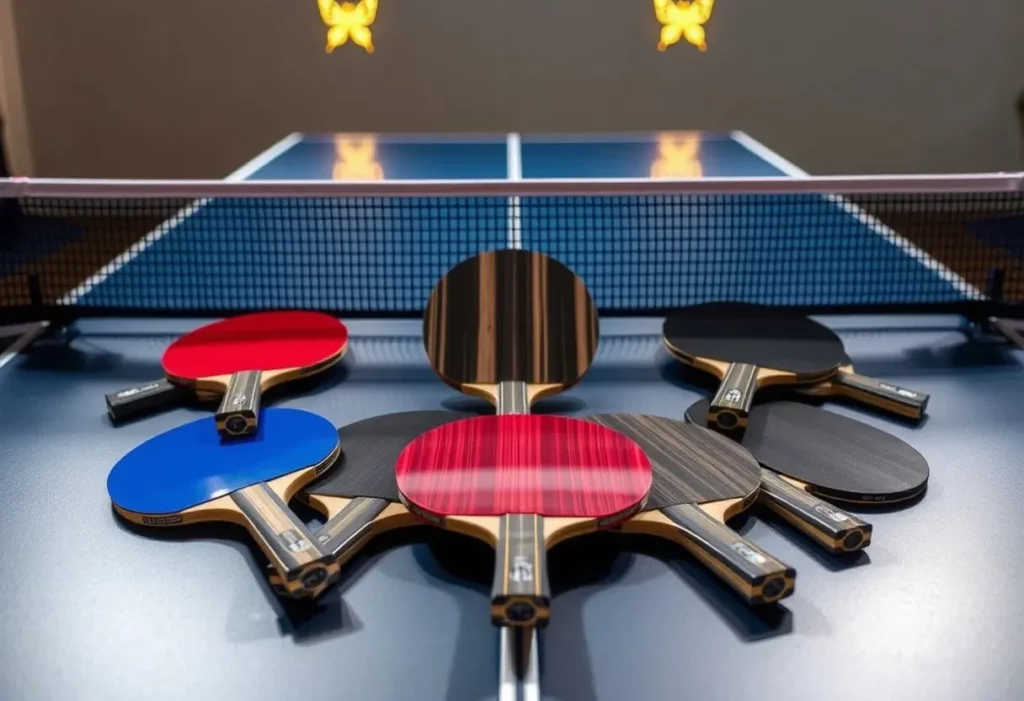
Now, let’s look into the different types of ping pong paddles available in the market. Understanding these types can help you make an informed decision when choosing the right paddle for your needs.
- Pre-assembled paddles: These are ready-made paddles that come with a pre-installed blade and rubber.
- Custom paddles: These are personalized paddles that allow you to choose your own blade and rubber combination.
- Specialty paddles: These are paddles designed for specific playing styles or techniques, such as anti-spin, long pips, and short pips paddles.
| Type of Paddle | Main Characteristics |
|---|---|
| Pre-assembled paddles | Ready-made paddles with pre-installed blade and rubber |
| Custom paddles | Personalized paddles with customizable blade and rubber combination |
| Specialty paddles | Paddles designed for specific playing styles or techniques |
| Anti-spin paddles | Paddles designed to reduce spin and speed |
| Long pips paddles | Paddles with long pips to increase spin and control |
| Short pips paddles | Paddles with short pips to increase speed and power |
Any serious table tennis player knows that choosing the right paddle can make all the difference in their game.
Pre-assembled paddles: Pros and cons of buying a ready-made paddle
Even though pre-assembled paddles are convenient and easy to use, they may not offer the customization options that some players need. Here are some pros and cons to consider:
| Pros | Cons |
|---|---|
| Convenient and easy to use | Limited customization options |
| Ready to use out of the box | May not suit individual playing styles |
| Affordable option | Quality may vary depending on manufacturer |
| Good for beginners | May not offer optimal performance for advanced players |
| Easy to replace | May not be durable enough for heavy use |
[When choosing a pre-assembled paddle, consider your playing style and skill level to ensure you get the right one for your needs.]
Custom paddles: Benefits of creating a personalized paddle
Even if you’re a beginner, creating a custom paddle can help you develop your unique playing style. Here are some benefits to consider:
Custom paddles offer the ultimate flexibility and customization options, allowing you to choose the perfect blade and rubber combination to suit your playing style and preferences. With a custom paddle, you can experiment with different materials, thicknesses, and designs to find the perfect fit for your game.
Types of custom paddles include those with specialized blades, such as carbon fiber or wooden blades, and rubbers with varying levels of spin, speed, and control. By choosing the right combination, you can optimize your performance and take your game to the next level.
Specialty paddles: Anti-spin, long pips, and short pips paddles explained
Paddles designed for specific playing styles or techniques can offer unique benefits and challenges. Here’s what you need to know:
Anti-spin paddles are designed to reduce spin and speed, making them ideal for players who prefer a more defensive game. Long pips paddles, on the other hand, increase spin and control, making them suitable for players who rely on finesse and placement. Short pips paddles, as the name suggests, offer increased speed and power, making them ideal for aggressive players.
explained, each type of specialty paddle has its own strengths and weaknesses, and choosing the right one depends on your playing style and preferences. By understanding the characteristics of each type, you can make an informed decision and optimize your performance on the table.
[When choosing a specialty paddle, consider your playing style and the specific techniques you want to employ to ensure you get the right one for your needs.]
[Note, the right paddle can enhance your performance, amplify your skills, and ultimately bring you closer to table tennis mastery.]
A Guide to Ping Pong Paddle Grips
For a table tennis player, the grip is a vital aspect of their game. It determines how you hold and control the paddle, affecting your shot accuracy, power, and overall playing experience.
Shakehand grip: Characteristics and benefits
Grips similar to a handshake are the most common type of grip used in ping pong. This style provides a secure and comfortable hold, allowing for greater wrist flexibility and versatility in shot selection.
The Shakehand grip is suited for various playing styles, making it a popular choice among players worldwide. With this grip, you can generate more power and spin on your shots, especially on the forehand side. Additionally, it allows for easier transitions between forehand and backhand strokes.
Penhold grip: Characteristics and benefits
Grips that resemble holding a pen are less common but still widely used, particularly in Asian countries. In this grip, you hold the handle between your thumb and forefinger, with your remaining fingers pressed against the back of the paddle.
The Penhold grip offers better control over forehand shots and enables quick transitions between forehand and backhand strokes. However, it may require more wrist movement and flexibility, which can be challenging for some players.
Grip adjustments are crucial when using the Penhold style, as it can affect your overall game. Experiment with different grip pressures and angles to find the perfect fit for your playing style.
Other grip styles: Exploring alternative grip options
With the abundance of grip styles available, it’s crucial to explore alternative options to find the one that suits you best [Experimenting with different grips can help you discover new techniques and improve your overall game].
Some players prefer a hybrid grip, combining elements of the Shakehand and Penhold styles. This grip can offer a balance between power and control, making it an attractive option for those who want to experiment with different playing styles.
For instance, you can try a grip that combines the comfort of the Shakehand style with the control of the Penhold style [Finding the perfect grip can take time and patience, but it’s worth the effort to improve your game].
Understanding Ping Pong Paddle Blades
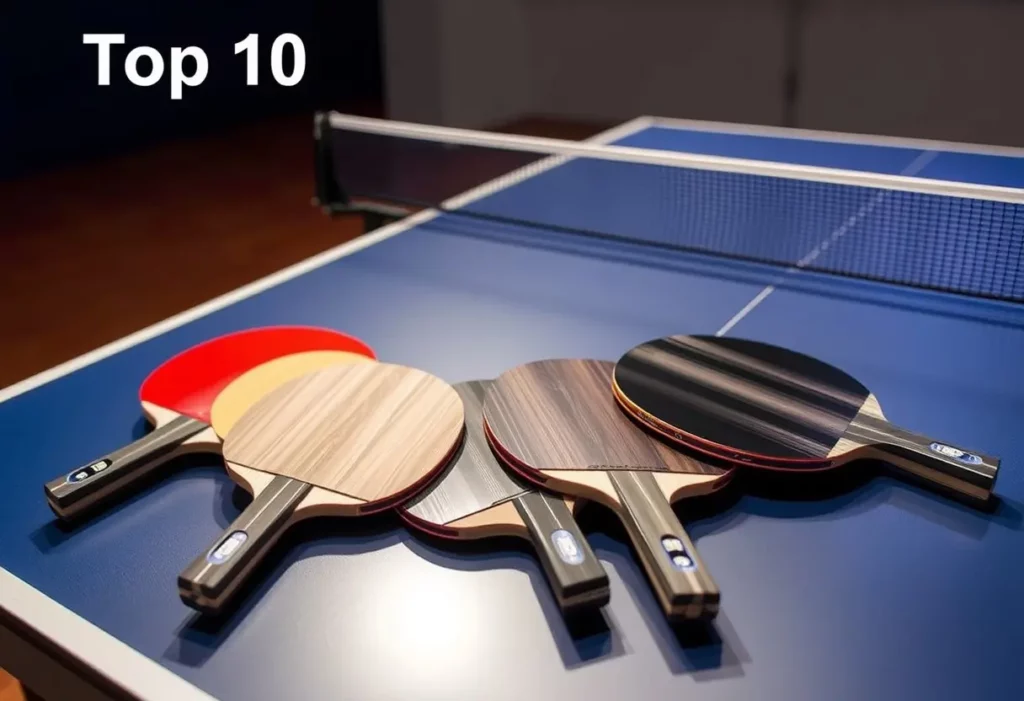
Many table tennis players underestimate the importance of the blade when choosing a ping pong paddle. However, the blade plays a significant role in determining the paddle’s performance, and understanding its composition and characteristics is important for optimal gameplay.
Wood blades: The traditional choice for ping pong paddles
One of the most common types of blades is the wood blade, which has been used in ping pong paddles for decades. Wood blades are known for their control and stability, making them a popular choice among players who prioritize precision and consistency. They are typically made from multiple layers of wood, which provide a solid feel and excellent feedback.
Wood blades are suitable for players of all skill levels, from beginners to professionals. They offer a consistent and predictable performance, making them ideal for players who rely on technique and strategy rather than raw power and speed.
Carbon blades: The modern alternative for added speed and spin
While wood blades are traditional and reliable, carbon blades offer a modern alternative for players seeking added speed and spin. Carbon blades are made by combining wood layers with carbon fiber, which provides increased stiffness and responsiveness.
Carbon blades are ideal for players who prefer an aggressive, fast-paced game. They offer more power and speed compared to wood blades, making them suitable for players who rely on powerful loops and smashes.
Ping pong players who use carbon blades can generate more spin and speed on their shots, thanks to the added stiffness and responsiveness of the blade. This makes carbon blades a popular choice among professional players and advanced enthusiasts who seek to dominate their opponents with powerful attacks.
Hybrid blades: Combining wood and carbon for optimal performance
Blades that combine wood and carbon layers offer a hybrid solution for players seeking the best of both worlds. Hybrid blades provide a balance between the control and stability of wood blades and the speed and spin of carbon blades.
Hybrid blades are suitable for players who want to combine power and control in their gameplay. They offer a unique blend of characteristics, making them ideal for players who adapt to different playing styles and situations.
This type of blade is particularly useful for players who need to adjust their game to counter different opponents or playing conditions. By combining the strengths of wood and carbon, hybrid blades provide a versatile and responsive performance that can help players stay ahead of the competition.
The Importance of Ping Pong Paddle Rubbers
All table tennis players know that the rubber on their ping pong paddle plays a critical role in their game. The right rubber can make all the difference in your performance, while the wrong one can hinder your progress. In this section, we’ll research into the importance of ping pong paddle rubbers and explore the various factors to consider when choosing the perfect rubber for your game.
Sponge Thickness: How it Affects Speed and Spin
Thickness matters when it comes to ping pong paddle rubbers. The sponge thickness affects the overall speed and spin of your shots. A thicker sponge (2mm or more) provides more power and speed, while a thinner sponge (1-1.5mm) offers more control and spin. [When choosing a sponge thickness, consider your playing style and the level of competition you’re in.]
For example, if you’re an aggressive player who relies on speed and power, a thicker sponge might be the way to go. On the other hand, if you’re a defensive player who focuses on control and spin, a thinner sponge could be more suitable. It’s necessary to find the right balance between speed and control to take your game to the next level.
Rubber Hardness: Measuring the Durometer Rating
An necessary aspect of ping pong paddle rubbers is their hardness, measured by the durometer rating. The durometer rating ranges from 30 to 80, with higher numbers indicating harder rubbers. [When dicking out a rubber, consider your playing style and the level of spin you want to generate.]
A harder rubber (60-80 durometer) provides more speed and less spin, while a softer rubber (30-50 durometer) offers more spin and control. If you’re a beginner, a softer rubber might be more forgiving and easier to control. However, if you’re an advanced player, a harder rubber could provide the speed and power you need to take your game to the next level.
With the right durometer rating, you can achieve the perfect balance between speed and spin. Experiment with different hardness levels to find the one that suits your playing style and preferences.
Rubber Texture: Smooth, Pimples, or Anti-Spin Rubbers Explained
Ping pong paddle rubbers come in various textures, each with its unique characteristics. Smooth rubbers offer a good balance of control and spin, while pimpled rubbers provide increased spin and speed. Anti-spin rubbers, on the other hand, are designed to reduce the opponent’s spin and make it harder for them to return your shots. [When choosing a rubber texture, consider your playing style and the type of game you want to play.]
For example, if you’re an aggressive player who likes to attack, pimpled rubbers might be the way to go. However, if you’re a defensive player who focuses on control and spin, smooth rubbers could be more suitable. Anti-spin rubbers are ideal for players who want to disrupt their opponent’s spin and create chaos on the table.
Importance of understanding the different rubber textures cannot be overstated. By choosing the right texture, you can gain a competitive edge and take your game to new heights.
Finding the Perfect Ping Pong Paddle for Your Style
Not every ping pong paddle is created equal, and what works for one player may not work for another. To find the perfect paddle for your style, you need to consider your playing style, skill level, and personal preferences.
Aggressive players: Paddles for those who like to attack
Aggressive players who like to take control of the game need a paddle that can keep up with their fast-paced style. Look for paddles with a stiff blade and thicker sponge (around 2.0-2.2mm) to generate more power and speed. [When choosing a paddle for aggressive play, consider the rubber’s hardness and sponge thickness to ensure maximum power and spin.]
Additionally, consider paddles with a shorter handle to allow for more wrist flexibility and quicker reactions. A paddle with a tacky rubber surface can also help generate more spin and control, making it easier to dominate the game.
Defensive players: Paddles for those who like to control
Some players prefer a more defensive approach, focusing on controlling the ball and wearing down their opponents. For these players, a paddle with a softer blade and thinner sponge (around 1.5-1.8mm) is ideal.
This type of paddle provides more control and feel, allowing players to place the ball precisely and consistently. Look for paddles with a longer handle to provide more leverage and control, and consider a paddle with a smooth rubber surface to reduce spin and increase predictability.
Those who prefer a defensive style often prioritize control over power, so a paddle with a larger sweet spot and a more forgiving blade can help them achieve consistent results.
All-around players: Paddles for those who like to do it all
Like many players, you may not fit neatly into an aggressive or defensive category. If you’re an all-around player who likes to mix up your game, look for a paddle that offers a balance of speed, control, and spin.
Pong enthusiasts who want to do it all need a paddle that can adapt to different playing styles and situations. Consider a paddle with a medium-stiff blade and a sponge thickness around 1.8-2.0mm to provide a balance of power and control.
A paddle with a balanced weight distribution and a comfortable grip size can also help all-around players maintain consistency and endurance throughout the game.
Tips for Choosing the Right Ping Pong Paddle
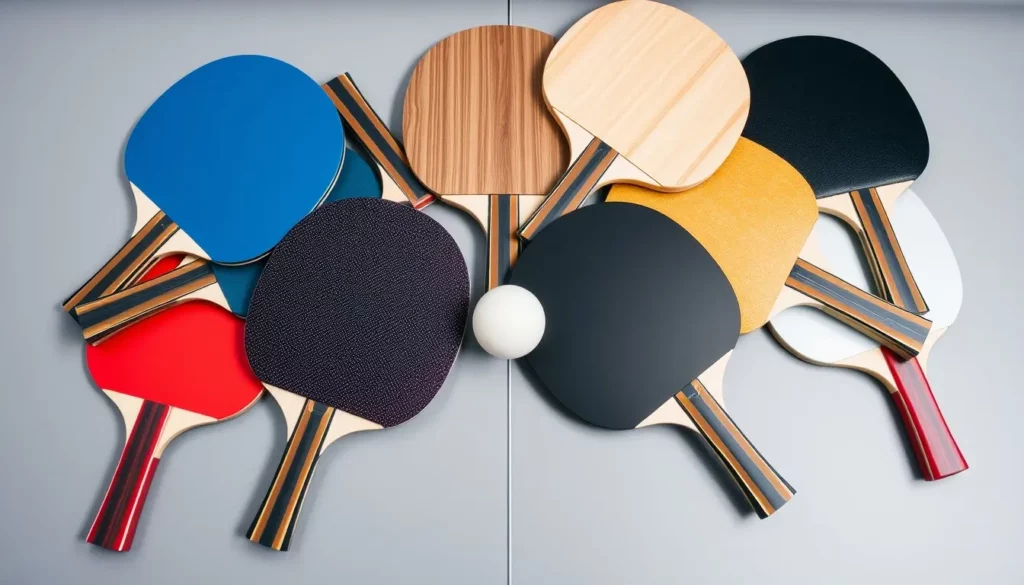
Many factors come into play when selecting the perfect ping pong paddle. To ensure you make the right choice, consider the following imperative tips:
- Grip: Look for a paddle with a comfortable and secure grip that suits your playing style.
- Blade: Choose a blade that balances speed, control, and flexibility according to your skill level and playing style.
- Rubber: Select the right rubber type and thickness to suit your game, considering factors like spin, control, and speed.
- Spin and Control: If you prioritize spin, look for paddles with grip-enhancing features. For control, opt for a paddle with a larger sweet spot and a more forgiving blade.
- Speed and Power: If you prefer an aggressive game, choose a paddle with a stiffer blade and thicker sponge. For finesse and placement, select a paddle with a softer blade and thinner sponge.
- Weight and Balance: Experiment with different weights and balance points to find the combination that feels most natural and allows for effortless maneuverability.
Knowing these factors will help you make an informed decision and find the perfect ping pong paddle to enhance your game.
Consider your playing style and strengths
There’s no one-size-fits-all approach to choosing a ping pong paddle. Your playing style and strengths play a significant role in determining the right paddle for you. If you’re an aggressive player who relies on power and speed, you’ll want a paddle that can keep up with your game. On the other hand, if you’re a defensive player who focuses on control and placement, you’ll need a paddle that provides precision and stability.
Take an honest assessment of your playing style and strengths to determine what type of paddle will help you excel on the table. Consider your technique, footwork, and shot selection to get a better understanding of what you need from your paddle.
Think about your opponents and their playing styles
To gain a competitive edge, it’s imperative to consider your opponents’ playing styles and adjust your paddle choice accordingly. If you frequently face opponents who rely on spin and control, you may want a paddle that can counter their tactics with increased speed and power. Conversely, if you often play against aggressive opponents, a paddle with enhanced control and precision may be more suitable.
For instance, if you’re facing an opponent who uses a lot of spin, you may want a paddle with a tacky rubber to help counter their spin and generate more control.
Don’t be afraid to try out different paddles
Right from the start, it’s imperative to experiment with different paddles to find the one that feels most comfortable and suits your playing style. Don’t be afraid to try out various grip styles, blade compositions, and rubber types to discover what works best for you. [Trying out different paddles is a crucial part of finding the right one, so don’t be afraid to experiment!]
Understanding that everyone’s playing style is unique, it’s vital to test different paddles to find the one that enhances your strengths and compensates for your weaknesses. By doing so, you’ll be able to make an informed decision and find the perfect ping pong paddle to take your game to the next level. [Finding the right paddle can make all the difference in your game, so don’t be afraid to try out different options!]
Step-by-Step Guide to Assembling Your Own Ping Pong Paddle
For those who want to take their ping pong game to the next level, assembling your own paddle can be a great way to customize your equipment to your specific needs and preferences. Here’s a step-by-step guide to help you assemble your own ping pong paddle:
| Step | Description |
|---|---|
| 1 | Choose the right blade and rubber combination |
| 2 | Apply the rubber to the blade |
| 3 | Final assembly and quality control |
Choosing the right blade and rubber combination
If you’re new to assembling your own ping pong paddle, choosing the right blade and rubber combination can be overwhelming. [Make sure to research and understand the characteristics of different blades and rubbers to ensure compatibility.] Here are some key factors to consider:
When selecting a blade, consider your playing style, skill level, and the type of game you want to play. For example, if you’re an aggressive player, you may want a blade with a stiffer construction and a thicker sponge. On the other hand, if you’re a defensive player, you may prefer a blade with a softer construction and a thinner sponge.
Pertaining to rubber, consider the type of spin and control you want to achieve. Smooth rubbers offer good control and spin, while pimpled rubbers provide increased spin and speed. Additionally, consider the thickness of the rubber sponge, as it affects the paddle’s overall speed and responsiveness.
Applying the rubber to the blade
There’s more to applying the rubber to the blade than just gluing it on. [Make sure to follow the manufacturer’s instructions and use the right adhesive to ensure a strong bond.] Here are some key steps to follow:
First, clean the blade and rubber surfaces to ensure a strong bond. Next, apply a thin layer of adhesive to the blade and attach the rubber sheet. Make sure to align the rubber sheet correctly and apply even pressure to avoid air bubbles.
Once the rubber is attached, use a roller or a similar tool to remove any air bubbles and ensure a smooth, even surface. Finally, allow the adhesive to dry completely before handling the paddle.
In addition to following the manufacturer’s instructions, it’s also important to consider the type of adhesive used and the environmental conditions during the application process. This can affect the strength and durability of the bond between the blade and rubber.
Final assembly and quality control
Step-by-Step, follow the manufacturer’s instructions to assemble the paddle handle and attach it to the blade. [Make sure to tighten the screws securely to avoid any loose parts during gameplay.]
Once the paddle is assembled, inspect it for any defects or imperfections. Check the rubber surface for any air bubbles or unevenness, and make sure the handle is securely attached to the blade.
Plus, test the paddle on the table to ensure it meets your performance expectations. Make any necessary adjustments to the rubber or blade to achieve the desired level of spin, control, and speed.
Common Mistakes to Avoid When Buying a Ping Pong Paddle
After investing time and effort into improving your table tennis skills, the last thing you want is to hinder your progress with a subpar ping pong paddle. To help you avoid common mistakes, we’ve compiled a list of pitfalls to steer clear of when buying a ping pong paddle.
Not considering your playing style
Some players make the mistake of choosing a paddle based on its popularity or a friend’s recommendation, without considering their own playing style. [It’s important to choose a paddle that complements your strengths and weaknesses.] This can lead to a paddle that doesn’t suit your game, resulting in frustration and poor performance. Take the time to reflect on your playing style, including your strengths, weaknesses, and preferences. Do you prioritize spin, control, or speed? Are you an aggressive player or a defensive one? Answering these questions will help you narrow down your options and find a paddle that’s tailored to your needs.
When choosing a paddle, consider your playing style and skill level. If you’re a beginner, you may want a paddle with a larger sweet spot and more forgiveness. If you’re an advanced player, you may prefer a paddle with more speed and spin.
Not researching the manufacturer and quality
Even experienced players can fall prey to buying a low-quality paddle from an unknown manufacturer. This mistake can lead to a paddle that breaks easily, loses its performance over time, or doesn’t meet your expectations. Always research the manufacturer’s reputation, read reviews, and check the paddle’s quality before making a purchase. Look for manufacturers that specialize in table tennis equipment and have a proven track record of producing high-quality paddles.
Style and design are important, but they shouldn’t come at the expense of quality. A well-made paddle with high-quality materials will perform better and last longer than a cheaply made one.
Not reading reviews and doing your due diligence
Doing your research is crucial when buying a ping pong paddle. Reading reviews from other players, watching videos, and trying out different paddles can help you make an informed decision. [Don’t rely solely on the manufacturer’s claims or marketing hype – get feedback from real users.] Pay attention to the pros and cons of each paddle, and consider factors like durability, performance, and comfort. By doing your due diligence, you can avoid buying a paddle that doesn’t meet your needs.
Paddle reviews can provide valuable insights into a paddle’s performance, durability, and overall value. Look for reviews from players with similar playing styles and skill levels to get a more accurate assessment of the paddle’s capabilities.
By avoiding these common mistakes, you can find a ping pong paddle that complements your playing style, meets your needs, and helps you improve your game. Be mindful of, the right paddle can make all the difference in your table tennis journey.
Pros and Cons of Popular Ping Pong Paddle Brands
Your choice of ping pong paddle brand can significantly impact your game. Here’s a breakdown of the pros and cons of popular brands to help you make an informed decision:
| Brand | Pros | Cons |
|---|---|---|
| Butterfly | High-quality blades and rubbers, excellent spin and control | Expensive, may require adjustments for beginners |
| Donic | Offers a range of paddles for different playing styles, good balance of speed and control | May not be as durable as other brands, limited customization options |
| Stiga | Budget-friendly, impressive performance, and good control | May not be suitable for advanced players, limited customization options |
| XuShaoFa | High-quality materials, excellent speed and power | Expensive, may require adjustments for beginners |
| Joola | Good balance of speed and control, affordable | May not be as durable as other brands, limited customization options |
| Andro | High-quality materials, excellent spin and control | Expensive, may require adjustments for beginners |
| Tibhar | Good balance of speed and control, affordable | May not be as durable as other brands, limited customization options |
| YinHe | High-quality materials, excellent speed and power | Expensive, may require adjustments for beginners |
| Palio | Good balance of speed and control, affordable | May not be as durable as other brands, limited customization options |
Butterfly: Known for their high-quality blades and rubbers
Assuming you’re looking for a paddle that offers exceptional spin and control, Butterfly is an excellent choice. Their high-quality blades and rubbers provide a superior playing experience. However, [be prepared to invest in a higher-end paddle, as Butterfly products tend to be more expensive].
Butterfly paddles are designed to meet the needs of advanced players, offering a range of customization options to suit individual playing styles. With Butterfly, you can expect excellent spin and control, making it an ideal choice for players who prioritize precision and finesse.
Donic: Offering a range of paddles for different playing styles
Paddles from Donic cater to various playing styles, offering a good balance of speed and control. [Consider Donic if you’re looking for a paddle that adapts to your unique playing style].
Donic paddles are known for their good balance of speed and control, making them suitable for players of all skill levels. While they may not be as durable as other brands, Donic paddles offer excellent value for their price.
Different playing styles require different paddles, and Donic understands this. They offer a range of paddles that cater to specific playing styles, ensuring you find the perfect fit for your game. [Experiment with different Donic paddles to find the one that suits you best].
Stiga: A budget-friendly option with impressive performance
One of the most budget-friendly options on the market, Stiga paddles offer impressive performance without breaking the bank. [If you’re on a tight budget, Stiga is definitely worth considering].
Stiga paddles are known for their impressive performance and good control, making them an excellent choice for beginners and intermediate players. While they may not be suitable for advanced players, Stiga paddles offer excellent value for their price.
Known for their budget-friendly prices, Stiga paddles are an excellent option for those who want to try out table tennis without investing in an expensive paddle. With Stiga, you can expect good performance and control without breaking the bank.
How to Maintain and Care for Your Ping Pong Paddle
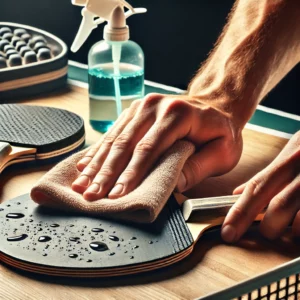
Despite the importance of choosing the right ping pong paddle, many players neglect to properly maintain and care for their equipment. This can lead to a decrease in performance, reduced lifespan, and even damage to the paddle. In this chapter, we will explore the crucial tips and techniques for maintaining and caring for your ping pong paddle.
Cleaning and storing your paddle
Some players tend to overlook the importance of cleaning their ping pong paddle, but it’s a crucial step in maintaining its performance and longevity. Use a soft, dry cloth to wipe away any dirt, sweat, or debris from the paddle’s surface. Avoid using harsh chemicals or abrasive materials that can damage the rubber or blade. When storing your paddle, keep it in a cool, dry place away from direct sunlight. [It’s crucial to store your paddle in a protective case or cover to prevent damage.]
For added protection, consider using a paddle cleaning solution specifically designed for table tennis equipment. These solutions can help remove stubborn dirt and grime without damaging the paddle’s surface. Additionally, store your paddle in a vertical position to prevent warping or bending of the blade.
Inspecting and replacing worn-out rubbers
Replacing worn-out rubbers is a critical aspect of maintaining your ping pong paddle. Over time, the rubber can wear down, losing its grip and spin. Replacing the rubber can breathe new life into your paddle, improving its performance and overall playability. [Regularly inspecting and replacing worn-out rubbers can significantly extend the lifespan of your paddle.]
When inspecting your paddle’s rubber, look for signs of wear, such as cracks, fading, or uneven surfaces. If you notice any of these signs, it’s time to replace the rubber. Choose a replacement rubber that matches the original specifications to ensure optimal performance.
With regular inspection and replacement, you can maintain your paddle’s performance and extend its lifespan. Note, a well-maintained paddle is crucial for achieving success in table tennis.
Tuning and customizing your paddle for optimal performance
Now that you’ve chosen the right ping pong paddle and learned how to maintain and care for it, it’s time to take your game to the next level by tuning and customizing your paddle for optimal performance. [Customizing your paddle can significantly improve your game, but it requires careful consideration and experimentation.]
Pong enthusiasts can experiment with different rubber thicknesses, blade compositions, and handle shapes to find the perfect combination that suits their playing style. Consider factors like spin, control, speed, and power when customizing your paddle. By fine-tuning your paddle, you can unlock new levels of performance and dominate the competition.
For advanced players, customizing the paddle can involve more complex modifications, such as adjusting the blade’s balance point or experimenting with different rubber compounds. However, it’s crucial to remember that customization should be done carefully and thoughtfully to avoid compromising the paddle’s overall performance. [Be cautious when customizing your paddle, as incorrect modifications can negatively impact its performance.]
Advanced Techniques for Getting the Most Out of Your Ping Pong Paddle
Unlike beginners, advanced players know that mastering the basics is just the starting point. To take your game to the next level, you need to develop advanced techniques that allow you to outmaneuver and outsmart your opponents.
Here are some advanced techniques to help you get the most out of your ping pong paddle:
- Spin Variation: Mastering different spin variations, such as topspin, backspin, and sidespin, can make your shots unpredictable and difficult to return.
- Paddle Angle Adjustment: Adjusting the angle of your paddle to match the incoming spin and speed of the ball can help you control the direction and pace of your shots.
- Footwork and Body Positioning: Developing good footwork and body positioning can help you get into position to hit winning shots and recover quickly for the next shot.
- Shot Selection and Placement: Choosing the right shot and placing it in the right spot on the table can make all the difference in winning or losing a point.
| Technique | Description |
|---|---|
| Spin Variation | Mastering different spin variations to make shots unpredictable and difficult to return. |
| Paddle Angle Adjustment | Adjusting the angle of the paddle to match the incoming spin and speed of the ball. |
| Footwork and Body Positioning | Developing good footwork and body positioning to get into position to hit winning shots and recover quickly. |
| Shot Selection and Placement | Choosing the right shot and placing it in the right spot on the table to win points. |
Using Spin to Deceive Your Opponents
While spin is an necessary part of table tennis, using it to deceive your opponents can take your game to the next level. By mastering different spin variations, you can make your shots unpredictable and difficult to return.
For example, using a heavy topspin on your forehand can make the ball dip down sharply, making it difficult for your opponent to return. On the other hand, using a light backspin on your backhand can make the ball float up, making it easy to attack.
Creating Variation with Different Strokes and Techniques
Strokes like the forehand, backhand, and smash are necessary to table tennis, but creating variation with different strokes and techniques can make your game more unpredictable and difficult to defend.
Pong players who can mix up their strokes and techniques can keep their opponents guessing and off balance. For example, using a short, soft shot to the middle of the table can be followed by a powerful, spinny shot to the corner.
Additionally, using different grips, such as the Shakehand or Penhold grip, can also add variation to your game. Experimenting with different grips and strokes can help you develop a unique playing style that sets you apart from your opponents.
Developing a Winning Strategy with Your Paddle
Variation is key to developing a winning strategy with your paddle. By mixing up your shots, spins, and techniques, you can keep your opponents guessing and off balance.
[Having a clear understanding of your opponent’s strengths and weaknesses is crucial to developing a winning strategy.]
To develop a winning strategy, start by analyzing your opponent’s game and identifying their strengths and weaknesses. Then, develop a plan to exploit their weaknesses and neutralize their strengths.
For example, if your opponent has a weak backhand, focus on attacking their backhand corner with powerful, spinny shots. On the other hand, if your opponent has a strong forehand, try to keep the ball away from their forehand corner and attack their backhand instead.
[Do not forget, a winning strategy is not just about winning points, but also about wearing down your opponent and gaining a psychological advantage.]
Final Words
Taking this into account, you now have a comprehensive understanding of the imperative factors to consider when choosing the perfect ping pong paddle for your game. From grip and blade to rubber, spin, and control, speed and power, and weight and balance, each aspect plays a vital role in enhancing your performance on the table tennis court. By considering your playing style, skill level, and personal preferences, you can make an informed decision and find the ideal paddle that suits your needs.
different types of paddles to find the one that feels the most comfortable and enhances your performance on the table. You can also consult with a coach or experienced player to get personalized recommendations.

